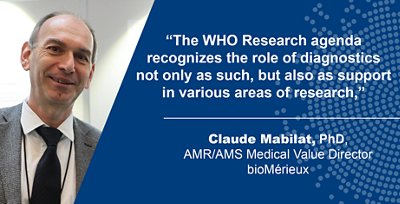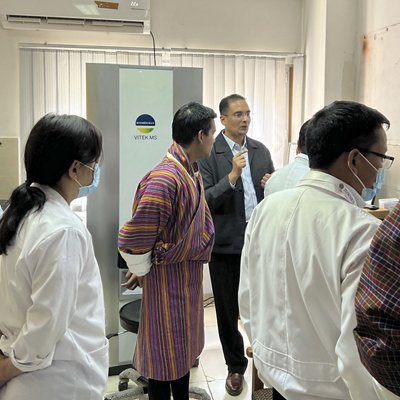Diagnostics, a pillar of WHO research priorities for battling antimicrobial resistance
By the bioMérieux Editors | Reading time: 2 min 30s
Featured Expert: Claude Mabilat, PhD, AMR/AMS Medical Value Director, Public & Governmental Affairs, bioMérieux
PUBLICATION DATE : AUGUST 10, 2023
Faced with the growing threat of antimicrobial resistance, the World Health Organization (WHO) has published, for the first time, a list of 40 priority research topics aimed at speeding up the implementation of concrete measures on a global scale. The roadmap emphasizes the importance of diagnostics.
Since 2015, thanks to the Global Action Plan to Combat Antimicrobial Resistance, many countries have committed to developing national plans to limit the emergence and transmission of antimicrobial-resistant infections.
Today, however, antimicrobial stewardship and infection prevention and control (IPC) programs are encountering challenges due to gaps in current knowledge and data.
To address this issue, the WHO has just unveiled a list of 40 priority research topics to be investigated by 2030. “Antimicrobial resistance is an urgent public health and economic challenge, and good quality research is a vital part of the response. To help preserve antimicrobials and save lives and livelihoods, this research agenda is a crucial tool for researchers and funders to prioritize research questions, and promptly and efficiently generate evidence that informs policy,” says Dr Hanan Balkhy, WHO Assistant Director-General for AMR, in a statement released in June.
These multidisciplinary priorities primarily target the most common resistant bacterial and fungal pathogens, according to the WHO. Eight priorities are directly devoted to diagnostic tests, an acknowledgment of their crucial role in the fight against antibiotic resistance.
The key role of diagnostics is acknowledged.

For Claude Mabilat, AMR/AMS Medical Value Director at bioMérieux, the importance given to diagnosis in this publication is a very pleasant surprise. “The WHO Research Agenda recognizes the role of diagnostics not only as such, but also as support in various areas of research,” he notes.
That focus is perhaps linked to the COVID-19 pandemic, which led to a sudden awareness of diagnostics’ important role in combating the spread of pathogens. From the perspective of health authorities, healthcare systems, and manufacturers, the role of diagnostics has become increasingly evident in the fight against antibiotic resistance as well.
“By highlighting diagnosis and defining a common language and shared orientations, this report will help the dialog with external partners, while serving as a catalyst for the activities in which we are already engaged,” underlines Mabilat.
New emphasis on economic impact.
Another novelty in this report is the introduction of economic criteria into the research priorities. Indeed, cost and return on investment criteria are put forward in the analysis of the various strategies and methods, whether for the prevention, control, diagnosis, treatment and care including antimicrobial consumption, and collection of epidemiological data.
“In addition to the medical benefit, early diagnosis and appropriate management of a severe infection, along with proper use of antibiotics, will reduce the length of hospital stay, and prevent unnecessary and costly treatments as well as long-term side effects. Therefore, a significant economic impact is also achieved, not only for the hospital but also for society. Taking this economic benefit into account is essential, but for the moment, few studies have been carried out in this area,” explains Mabilat.
Low- and middle-income countries at the heart of concerns.
Because the impact of growing antimicrobial resistance is greater in low- and middle-income countries, the WHO publication puts specific emphasis on the need for solutions that can easily be deployed in those countries.
In terms of detecting the susceptibility of pathogens to available antibiotics for diagnosis, there is a particular demand for tools that are simple to use in different subpopulations, in particular at the point of care, in a context of limited resources, allowing quick and precise results and, of course, at an affordable price. “That's a lot of constraints!“ says Claude Mabilat. “To distinguish bacterial infections from viral infections, and thus limit the consumption of antibiotics, a good solution would be to identify one or more effective biomarkers that could be embedded in a lateral flow or PCR device.”
In addition to specific diagnostic tools, global monitoring of antibiotic use is necessary to help curb resistance in all countries. bioMérieux supports the Global-PPS, a survey on antibiotic consumption and resistance in hospitals around the world. Conducted by the University of Antwerp, this survey provides a free and easy-to-implement online tool to measure and monitor antibiotic prescribing and antibiotic resistance in hospitalized adults, children, and newborns.
You may be interested in these articles
SHARE THIS:
- SITES - Blog
- AMR AMS
< SWIPE FOR MORE ARTICLES >
-2?qlt=85&ts=1692797716570&dpr=off)

